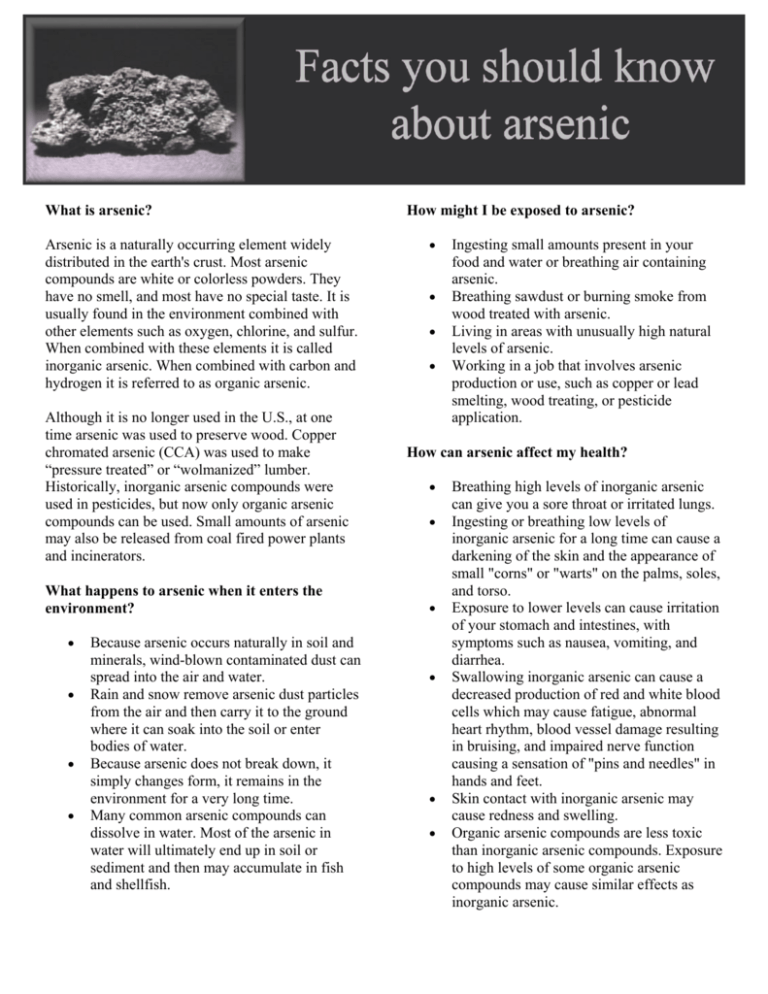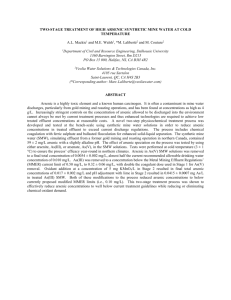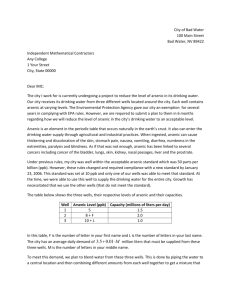What is arsenic? Arsenic is a naturally occurring element widely
advertisement

What is arsenic? Arsenic is a naturally occurring element widely distributed in the earth's crust. Most arsenic compounds are white or colorless powders. They have no smell, and most have no special taste. It is usually found in the environment combined with other elements such as oxygen, chlorine, and sulfur. When combined with these elements it is called inorganic arsenic. When combined with carbon and hydrogen it is referred to as organic arsenic. Although it is no longer used in the U.S., at one time arsenic was used to preserve wood. Copper chromated arsenic (CCA) was used to make “pressure treated” or “wolmanized” lumber. Historically, inorganic arsenic compounds were used in pesticides, but now only organic arsenic compounds can be used. Small amounts of arsenic may also be released from coal fired power plants and incinerators. What happens to arsenic when it enters the environment? • • • • Because arsenic occurs naturally in soil and minerals, wind-blown contaminated dust can spread into the air and water. Rain and snow remove arsenic dust particles from the air and then carry it to the ground where it can soak into the soil or enter bodies of water. Because arsenic does not break down, it simply changes form, it remains in the environment for a very long time. Many common arsenic compounds can dissolve in water. Most of the arsenic in water will ultimately end up in soil or sediment and then may accumulate in fish and shellfish. How might I be exposed to arsenic? • • • • Ingesting small amounts present in your food and water or breathing air containing arsenic. Breathing sawdust or burning smoke from wood treated with arsenic. Living in areas with unusually high natural levels of arsenic. Working in a job that involves arsenic production or use, such as copper or lead smelting, wood treating, or pesticide application. How can arsenic affect my health? • • • • • • Breathing high levels of inorganic arsenic can give you a sore throat or irritated lungs. Ingesting or breathing low levels of inorganic arsenic for a long time can cause a darkening of the skin and the appearance of small "corns" or "warts" on the palms, soles, and torso. Exposure to lower levels can cause irritation of your stomach and intestines, with symptoms such as nausea, vomiting, and diarrhea. Swallowing inorganic arsenic can cause a decreased production of red and white blood cells which may cause fatigue, abnormal heart rhythm, blood vessel damage resulting in bruising, and impaired nerve function causing a sensation of "pins and needles" in hands and feet. Skin contact with inorganic arsenic may cause redness and swelling. Organic arsenic compounds are less toxic than inorganic arsenic compounds. Exposure to high levels of some organic arsenic compounds may cause similar effects as inorganic arsenic. How does arsenic effect children? There is some evidence that suggests that long-term exposure to arsenic in children may result in lower IQ scores. Some evidence has shown that inhaled or ingested arsenic can injure pregnant women or their unborn babies, although the studies are not definitive. Studies in animals show that large doses of arsenic that cause illness in pregnant females can also cause low birth weight, fetal malformations, and even fetal death. Arsenic can cross the placenta and has been found in fetal tissues. Arsenic is found at low levels in breast milk. How can families reduce their risk of exposure to arsenic? • • • • Avoid inhalation of sawdust from arsenictreated lumber. Never burn any treated lumber or sawdust. Families with decks, play equipment, furniture, or other structures made with arsenic-treated lumber can reduce exposure for children by covering the lumber with paint or other sealer. Have everyone wash hands before eating. Is there a medical test to show whether I’ve been exposed to arsenic? There are tests available to measure arsenic in your blood, urine, hair, and fingernails. The urine test is the most reliable test for arsenic exposure. These tests can determine if you have been exposed to above-average levels of arsenic. They cannot predict how the arsenic levels in your body will affect your health. For more information, contact the: Texas Department of State Health Services Environmental and Injury Epidemiology & Toxicology Group, 1100 West 49th Street, T-702, Austin, Texas 78756 Phone (800) 588-1248








